
I’ve just published my review of the Nikon Coolpix S570. The Nikon Coolpix S570 is the budget version of the S640 I recently reviewed, packing a similar 5X zoom lens and automatic operation. Check out the Nikon Coolpix S570 photo gallery to view sample photos as well.
DPInterface Nikon Coolpix S570 Review
Brad Soo – December 21st, 2009
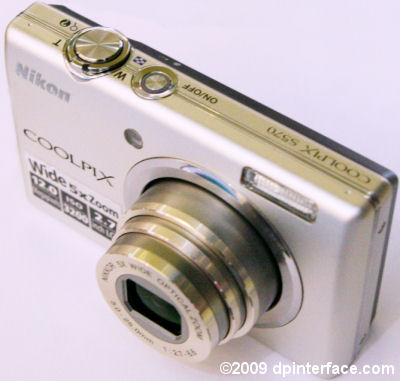
The Nikon Coolpix S570 is the latest budget offering from Nikon. The camera is very similar to the Coolpix S640 I recently reviewed; packing 12 megapixels of resolution, a 5X optical zoom lens (sans optical image stabilization), point-and-shoot operation and VGA movie mode. And the differences? Not many; but Nikon did remove optical image stabilization, “super-fast†startup/AF and stuff in a smaller, lower capacity battery on the S570. You do save about $80 if you choose to pick the Coolpix S570 over the S640, however. Find out more about the Nikon Coolpix S570 now!
Size and Weight
Closest competitors:
(159.9) 89.5 x 54.9 x 20.0 mm (120 g) - Canon PowerShot SD940 IS Digital ELPH
(176.2) 99.9 x 53.4 x 22.9 mm (130 g) - Canon PowerShot SD980 IS Digital ELPH
(180.9) 99.8 x 58.5 x 22.6 mm (146 g) – Casio Exilim FC150
(172.8) 96.5 x 55.9 x 20.3 mm (130 g) – Casio Exilim Z450
(180.0) 97.7 x 58.9 x 23.4 mm (153 g) - Fujifilm FinePix F200 EXR
(172.5) 92.0 x 57.9 x 22.6 mm (151 g) - Fujifilm FinePix J250
(170.0) 92.0 x 56.5 x 21.5 mm (120 g) – Nikon Coolpix S570
(166.5) 91.0 x 55.0 x 20.5 mm (110 g) – Nikon Coolpix S640
(173.1) 97.5 x 55.7 x 26.2 mm (125 g) – Olympus Stylus 7010
(173.1) 95.7 x 59.6 x 20.2 mm (131 g) - Panasonic Lumix FP8
(172.5) 97.0 x 54.0 x 21.5 mm (105 g) – Pentax Optio P80
(167.7) 99.8 x 59.7 x 18.5 mm (149 g) – Samsung Dual View TL220
(176.8) 97.6 x 56.6 x 22.6 mm (135 g) - Sony Cyber-shot W290
(165.8) 90.5 x 51.8 x 19.8 mm (120 g) - Sony Cyber-shot WX1
All the weight figures above show when the camera is empty without a battery or memory card
For reasons unknown, the Coolpix S570 weighs a touch heavier and is very slightly larger than its image stabilization equipped sibling, the S640. Still, the Nikon Coolpix S570 is still a fairly small camera (more compact than most cameras in its class) and is very portable; you can bring it almost anywhere with you.
In the box
The Nikon Coolpix S570 comes with an average bunch of box contents:
- EN-EL10 Rechargeable lithium-ion battery
- Battery charger
- Wrist strap
- USB cable
- A/V cables
- Camera software CD
- User’s manual
The Nikon Coolpix S570 comes with a paltry 47 MB of internal memory, so go ahead and get a larger memory card because the built-in memory won’t be enough for normal shooting. The camera takes SD/SDHC memory cards and I would recommend 4 GB to begin with. A high-speed card is optional since the camera doesn’t perform significantly faster with one.
220 shots - Canon PowerShot SD940 IS Digital ELPH
240 shots - Canon PowerShot SD980 IS Digital ELPH
300 shots – Casio Exilim FC150
550 shots – Casio Exilim Z450
230 shots - Fujifilm FinePix F200 EXR
200 shots - Fujifilm FinePix J250
220 shots – Nikon Coolpix S570
270 shots – Nikon Coolpix S640
170 shots – Olympus Stylus 7010
380 shots - Panasonic Lumix FP8
200 shots – Pentax Optio P80
200 shots – Samsung Dual View TL220
330 shots – Sony Cyber-shot W290
350 shots – Sony Cyber-shot WX1
All the cameras above are rated with rechargeable batteries according to CIPA Standard
Unlike the Coolpix S640 I reviewed which used the EN-EL12 battery, the Nikon Coolpix S570 over here utilizes the even less powerful EN-EL10 rechargeable lithium-ion battery, which translates into battery life that borders ‘just’ average. Another difference here is that the Coolpix S570 comes with a more conventional battery charger, compared to the S640 which camera with an AC adapter.
Accessories
There are no accessories available for the Nikon Coolpix S570 besides an AC adapter and various camera cases.
Camera Tour
The Nikon Coolpix S570 has a fairly casual design that isn’t particularly striking. The camera sports a conventional look with good build quality and ergonomics. I’d say the Coolpix S570 handled slightly better than its sibling, the S640, because of its sizable buttons and the fact there isn’t a scroll wheel to accidentally bump on the camera. The Nikon Coolpix S570 comes in your choice of five colors: silver, black, blue, pink and red; though for some odd reason, not all colors will be available everywhere.

The Nikon Coolpix S570 sports a 5X optical zoom lens similar to the one found on the S640. The lens covers a range of 28 – 140 mm, with an aperture range of f2.7 – f6.6. The main difference here is that the Coolpix S570’s version of the lens lacks optical image stabilization. I don’t know why Nikon would leave out such an important feature, but supposedly it’s one of the compromises that gets you the S570 at a price 33% lower than that of the Coolpix S640. Combined with the camera’s slow aperture at the telephoto end, this means the Coolpix S570 may not be such a good choice for shooting at/near maximum zoom when lighting isn’t that good.
To the upper left side is the Coolpix S570’s autofocus assist lamp that doubles as a self-timer lamp. That brings us to the camera’s flash which is quite powerful: at Auto ISO, it covers a range of 50 cm to 5.5 m (about 18 feet) at wide-angle, up to 2.2 m (7 feet) at telephoto. Of course, these numbers were obtained with ISO set to Auto, and effective range may be reduced when using ISOs… but nevertheless those are still impressive numbers there. The camera’s microphone is located to the lower left of the lens (spot the two holes).
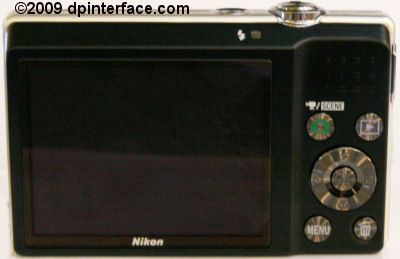
There’s a 2.7 inch LCD display on the back of the Nikon Coolpix S570, which has a decent pixel count of 230,000. Visibility was good in low-light but just okay under bright light. You’ll probably have to tilt the camera a little to find the right viewing angle outdoors. There’s a flash status indicator located above the LCD display.

The first two buttons are the shooting mode and direct playback buttons respectively. Pressing the shooting mode button will bring up the screen above and allow you to pick one of the numerous point-and-shoot modes on the camera.
Next is the Coolpix S570’s five-way navigation pad:
- Up – Flash setting (Auto, auto with red-eye reduction, off, on, slow sync, rear-curtain sync)
- Down – Focus mode (Normal, macro, infinity)
- Left – Self timer (Off, 2 seconds, 10 seconds, smile timer, blink proof)
- Right - Exposure compensation (+/-2 EV in 1/3 step increments)
- Center – OK/Set
The last two buttons at the bottom are for bringing up the camera MENU and deleting photos respectively.
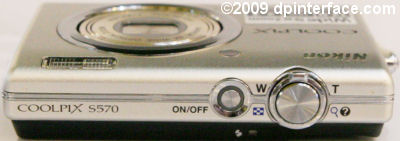
The top of the Coolpix S570 is pretty simple with just the camera’s power button and shutter button with a zoom controller wrapped around it.

This side of the Coolpix S570 is blank.
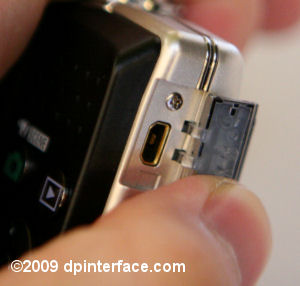
On this side of the camera is its single connector port used for both A/V Out and USB connections
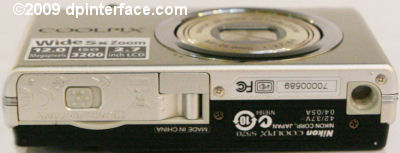
At the bottom of the Nikon Coolpix S570 are its battery/memory card compartment with an average-quality door over it and tripod mount. You can swap batteries/memory cards while the camera is on a tripod.
Taking pictures (Shooting mode)
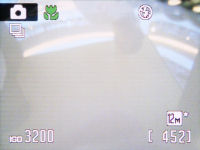
Not much to see here, the Nikon Coolpix S570 doesn’t say much about photos when you’re composing them. It does show a zoom indicator, low battery indicator and exposure info but that’s about it.
The Nikon Coolpix S570 has quite a number of image resolution options as well as two compression settings (but as usual, High quality is only available for the highest resolution, other image sizes are fixed to Normal quality). Image resolution choices include 12 MP, 8 MP, 5 MP, 3 MP, 1 MP, VGA and widescreen 16:9 (at 8.8 MP).
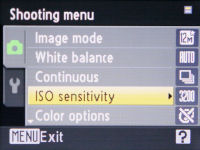

The Nikon Coolpix S570 has the standard issue, tabbed Nikon menu interface. The S570’s camera menu contains less options than that of the S640, metering mode and autofocus mode are two notable things missing here.
- Image mode (resolution/compression)
- White balance (Auto, daylight, incandescent, fluorescent, cloudy, flash, custom)
- Drive mode (Single-shot, continuous shooting, best shot selector)
- ISO sensitivity (Auto, fixed range auto, 100, 200, 400, 800, 1600, 3200, 6400)
- Color options (Standard, vivid, monochrome, sepia, cyan, pastel)
- Focus area (Face detection, auto, center point, flexible)
Face Detection (Nikon Smart Portrait)
The Coolpix S570 has Nikon’s standard-issue Smart Portrait feature set which can come in handy when taking photos of people. Smart Portrait consists of a few ‘detection’ features related to people photos, including face detection (up to 12 faces in a frame), software-based redeye removal and blink detection.
Blink detection comes in two forms: The passive blink warning, which displays an on-screen notice if someone blinked, or the more pro-active Blink Proof mode, which takes two pictures in a row and picks the shot with your subject(s)’ eyes open. There’s also smile detection in the form of Smile Timer mode, where the camera starts counting down to take a picture when a smile is detected. One new addition to Nikon’s Smart Portrait suite is the skin softening function, which allows you adjust from 3 levels of softening so your subjects have smooth skin.
Macro and Scene modes
- Auto mode – More like Program mode, mostly automatic shooting but you can change some camera settings
- Scene modes
- Smile detection
- Movie mode
The Nikon Coolpix S570 has a macro mode that lets you go as close as 3 cm to your subject at wide-angle. The camera allows you to zoom in slightly as well. This is slightly different versus the Coolpix S640’s 2 cm macro mode.
The Nikon Coolpix S570 has the same set of numerous scene modes shared by Nikon’s other compact cameras; which include portrait, landscape, sports mode, night portrait, party/indoor, beach/snow, sunset, dusk/dawn, night landscape, close-up, food, panorama assist, museum, fireworks, copy and backlight. If you find yourself having a hard to time trying to pick a scene mode, you can let the camera choose for you using the scene auto selector mode.
Video Recording
The Nikon Coolpix S570 has a regular VGA movie mode that allows you to record 640 x 480 videos at 30 FPS with mono sound. The camera can record them at 30 FPS with mono sound up to 2 GB per movie clip (around 30 minutes) in AVI Motion JPEG format. You are able to use digital zoom and electronic image stabilization while recording movies (though they may lower video quality).
Performance
All performance testing of the Nikon Coolpix S570 was performed using a high-speed 4 GB SanDisk Ultra II SDHC (90X) card.
The Nikon Coolpix S570 has a decent startup time of 1.6 seconds (startup animation off); decent because some cameras are even faster. Focusing times were quite good, clocking in at roughly 0.2 to 0.4 seconds at wide-angle and double that at telephoto. Accuracy in low-light was decent, though the camera can be unsure at times as you reach maximum zoom.
- Shot-to-shot speed - 1 shot every 1.9 seconds, fairly decent
- Flash recharge time using a fully charged battery - 3 seconds
The Nikon Coolpix S570’s continuous shooting mode is poor; with the camera firing away at a leisurely 0.7 frames per second and slowing down even more after taking a few photos. Overall, the Nikon Coolpix S570 churns out performance numbers that are either average or below average.
Image Quality
Time for image quality tests with the Nikon Coolpix S570:






Noise is somewhat noticeable at ISO 100 and 200, but photos are nevertheless usable for printing. At ISO 400, noise goes up with noise reduction, giving photos a grainy, watery look. And details are wiped out at ISO 800 (note the line separating individual colors are smudged); making image quality unusable at this level.
The quality of photos shot at ISO 1600 and ISO 3200 speak for themselves – the numbers are just there for marketing purposes (the S640 takes things one step “higher†with an insane, unusable ISO 6400 setting) and not for practical use.

There’s very low distortion to be seen with the Coolpix S570’s lens, but poor overall sharpness (especially the corners) and a tiny bit of color fringing. Redeye was a non-issue as the camera automatically removes any it detects in photos.
Frankly, I’m not surprised that the Coolpix S570 produces image quality much like that of the S640. The camera, using Nikon’s “old†approach of handling images over-processes photos, giving them an overall soft look which lacks detail. Take into account the camera’s lens’ weak points and you’ll quickly figure the Coolpix S570 is a camera you’d want to use in bright light only. And even then, sticking to low ISO settings.
Photo gallery
Head on to the Nikon Coolpix S570 photo gallery to view full-sized sample pictures from the camera.
Playback

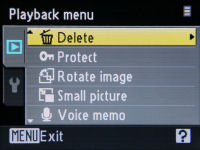
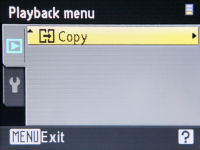
The Nikon Coolpix S570 shares the same standard playback mode as the S640. There’s print marking, image protection and rotation, voice clip attachment, slideshow view and playback zoom (up to 10X). You can copy images between the camera and your memory card, or choose to create a ‘small pic’ version of any image.
The Coolpix S570 has three simple editing tools: Quick Retouch adjusts brightness, contrast and saturation to apparently make photos look better, D-Lighting brightens up dark areas in photos and skin softening, which is self-explanatory.

The Nikon Coolpix S570 doesn’t tell you anything about your photos in playback. What you see above is what you’ll get.
Conclusion
I’m sure everyone’s heard of the saying that you pay for what you get. In the case of the Nikon Coolpix S570, you’re not paying a lot; so don’t expect an exceptional camera with a whole lot of bells and whistles. Instead, you’re getting a fairly average point-and-shoot device at about $200. The Nikon Coolpix S570 is compact with average battery life and acceptable build quality.
The Nikon Coolpix S570 has a 5X optical zoom lens that has the same focal coverage and aperture range as the S640, but minus optical image stabilization. The camera’s slow lens aperture, lack of real image stabilization and image quality that’s only usable up to ISO 200/400 means the Coolpix S570’s use is almost limited exclusively to shooting in well-lit conditions (unless you bring a tripod around).
No manual controls, plenty of scene modes and sub-standard VGA movie mode, the Coolpix S570 reminds me a lot of Olympus’ super-budget FE-series. The camera is also missing things like metering mode and continuous AF options found on the Coolpix S640. At least there’s auto scene selection in shooting mode and three post-shooting editing tools in playback. The camera isn’t particularly fast, with below average continuous shooting and decent focusing and startup times.
The Nikon Coolpix S570 is ironically an el-cheapo camera that doesn’t offer good value. It’s a poor performer in low-light; limiting you to shooting outdoors or in bright light unless you enjoy lugging around a tripod or hunting for flat surfaces to perch the camera. It’s doesn’t stand out in any other particular area either and is no better a deal than the S640. If you want a cheap camera with above average amount of zoom, then I think Panasonic’s budget FS-series are a better choice with less compromises.
What’s hot:
- Acceptable image quality at lower ISOs; suited for outdoor shooting
- Acceptable performance for point-and-snapping
- 5X optical zoom lens
- Automatic scene selection, many scene modes, elaborate face detection/portrait features
What’s not:
- Image softness, poor ISO performance and below average image clarity
- Slow lens aperture range at max zoom; no real image stabilization
- No manual controls; scarce on-screen display details
- Slow burst mode and below average writing times
Camera rating: (Ratings guide)
- 3.0 - Design and build quality
- 3.0 - Bundle in the box
- 2.2 - Lens (Zoom, aperture range, image stabilization)
- 2.6 - Feature set and manual controls
- 3.5 - Ergonomics and ease of use
- 3.0 - Performance and speed
- 3.2 - Image quality
- 5.86 over 10.0 - Overall rating (Below average)

I received this camera for christmas this year. I am happy to say this review is dead on, it even helped me fix a few problems with the camera. I tried a lot of different settings to improve the image but the main thing that would improve any picture taken on this camera would be the option of having “shake reduction.” I, like you, have no idea why they would take out (other than monetary purposes) such a necessary feature.
I’ve had a Nikon S510 a while back which I loved, and the Nikon S570 is even better. I like vivid colors, and when set to “vivid”, the Nikon S570 produces photos with beautiful vivid colors and excellent contrast. The wide angle lens has great edge to edge sharpness. The Nikon S570 performs well, probably not the fastest (shutter lag and start-up time), but good nonetheless.